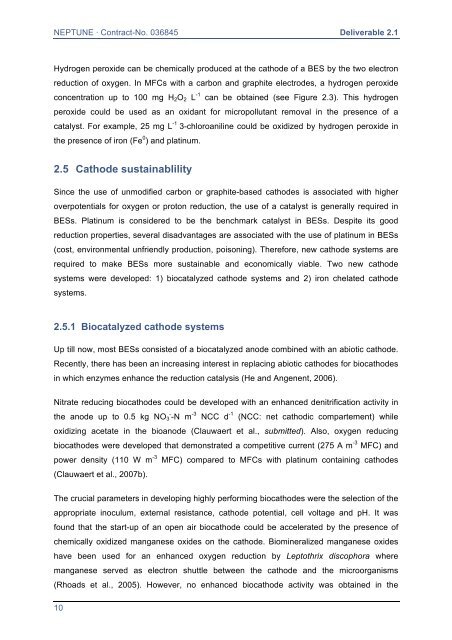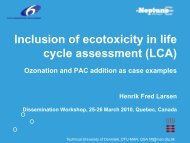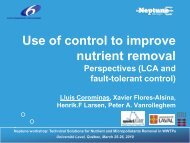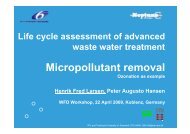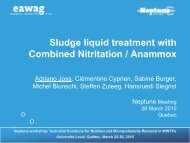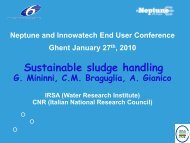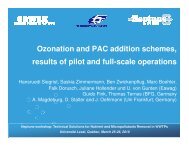D2.1 - EU Project Neptune
D2.1 - EU Project Neptune
D2.1 - EU Project Neptune
You also want an ePaper? Increase the reach of your titles
YUMPU automatically turns print PDFs into web optimized ePapers that Google loves.
NEPTUNE · Contract-No. 036845 Deliverable 2.1<br />
Hydrogen peroxide can be chemically produced at the cathode of a BES by the two electron<br />
reduction of oxygen. In MFCs with a carbon and graphite electrodes, a hydrogen peroxide<br />
concentration up to 100 mg H 2 O 2 L -1 can be obtained (see Figure 2.3). This hydrogen<br />
peroxide could be used as an oxidant for micropollutant removal in the presence of a<br />
catalyst. For example, 25 mg L -1 3-chloroaniline could be oxidized by hydrogen peroxide in<br />
the presence of iron (Fe 0 ) and platinum.<br />
2.5 Cathode sustainablility<br />
Since the use of unmodified carbon or graphite-based cathodes is associated with higher<br />
overpotentials for oxygen or proton reduction, the use of a catalyst is generally required in<br />
BESs. Platinum is considered to be the benchmark catalyst in BESs. Despite its good<br />
reduction properties, several disadvantages are associated with the use of platinum in BESs<br />
(cost, environmental unfriendly production, poisoning). Therefore, new cathode systems are<br />
required to make BESs more sustainable and economically viable. Two new cathode<br />
systems were developed: 1) biocatalyzed cathode systems and 2) iron chelated cathode<br />
systems.<br />
2.5.1 Biocatalyzed cathode systems<br />
Up till now, most BESs consisted of a biocatalyzed anode combined with an abiotic cathode.<br />
Recently, there has been an increasing interest in replacing abiotic cathodes for biocathodes<br />
in which enzymes enhance the reduction catalysis (He and Angenent, 2006).<br />
Nitrate reducing biocathodes could be developed with an enhanced denitrification activity in<br />
the anode up to 0.5 kg NO - 3 -N m -3 NCC d -1 (NCC: net cathodic compartement) while<br />
oxidizing acetate in the bioanode (Clauwaert et al., submitted). Also, oxygen reducing<br />
biocathodes were developed that demonstrated a competitive current (275 A m -3 MFC) and<br />
power density (110 W m -3 MFC) compared to MFCs with platinum containing cathodes<br />
(Clauwaert et al., 2007b).<br />
The crucial parameters in developing highly performing biocathodes were the selection of the<br />
appropriate inoculum, external resistance, cathode potential, cell voltage and pH. It was<br />
found that the start-up of an open air biocathode could be accelerated by the presence of<br />
chemically oxidized manganese oxides on the cathode. Biomineralized manganese oxides<br />
have been used for an enhanced oxygen reduction by Leptothrix discophora where<br />
manganese served as electron shuttle between the cathode and the microorganisms<br />
(Rhoads et al., 2005). However, no enhanced biocathode activity was obtained in the<br />
10


